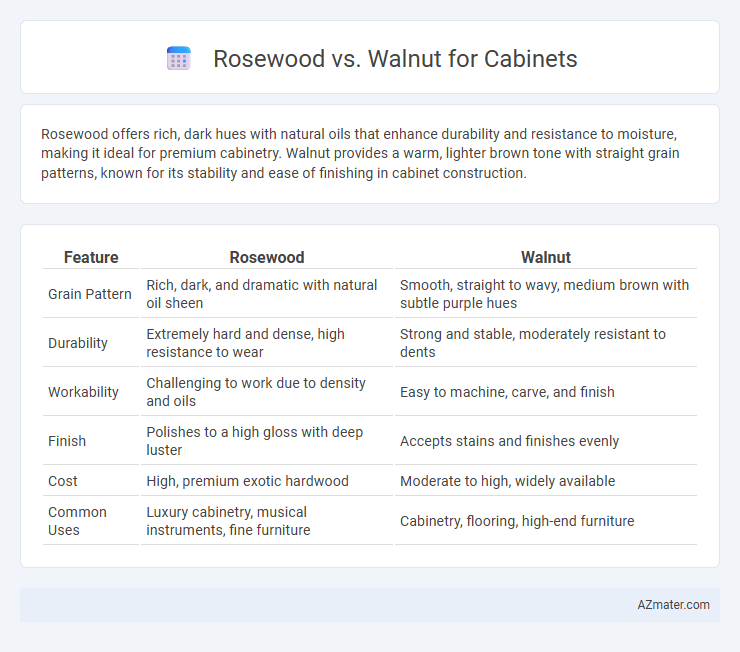Rosewood offers rich, dark hues with natural oils that enhance durability and resistance to moisture, making it ideal for premium cabinetry. Walnut provides a warm, lighter brown tone with straight grain patterns, known for its stability and ease of finishing in cabinet construction.
Table of Comparison
| Feature | Rosewood | Walnut |
|---|---|---|
| Grain Pattern | Rich, dark, and dramatic with natural oil sheen | Smooth, straight to wavy, medium brown with subtle purple hues |
| Durability | Extremely hard and dense, high resistance to wear | Strong and stable, moderately resistant to dents |
| Workability | Challenging to work due to density and oils | Easy to machine, carve, and finish |
| Finish | Polishes to a high gloss with deep luster | Accepts stains and finishes evenly |
| Cost | High, premium exotic hardwood | Moderate to high, widely available |
| Common Uses | Luxury cabinetry, musical instruments, fine furniture | Cabinetry, flooring, high-end furniture |
Introduction to Rosewood and Walnut Cabinets
Rosewood cabinets are prized for their rich, dark hues and distinctive grain patterns that add luxury and warmth to any interior. Walnut cabinets feature a smooth texture with a deep, chocolate-brown color and subtle grain that offers timeless elegance and durability. Both hardwood options provide excellent strength and unique aesthetic appeal, making them popular choices for high-end cabinetry.
Key Differences Between Rosewood and Walnut
Rosewood features a rich, dark reddish-brown color with dramatic grain patterns and natural oils that enhance durability and resistance to moisture, making it ideal for luxurious cabinetry. Walnut offers a warm, chocolate-brown tone with a straight, fine grain and a smooth finish, prized for its workability and consistent stability in construction. While rosewood is generally harder and more expensive, walnut is favored for its versatility and classic appearance in both modern and traditional cabinet designs.
Wood Grain and Appearance Comparison
Rosewood cabinets feature rich, dark reddish to purplish hues with striking, irregular grain patterns that create a bold, exotic look. Walnut offers a smoother, more consistent grain with warm brown tones and subtle variations, lending a classic and elegant appearance. The choice between rosewood and walnut depends on the desired aesthetic: rosewood's distinct, dramatic patterns contrast with walnut's refined, understated grain.
Durability and Hardness of Rosewood vs Walnut
Rosewood is renowned for its exceptional durability and hardness, often measuring around 2200 on the Janka hardness scale, making it highly resistant to dents and scratches in cabinetry. Walnut, while still durable, has a lower Janka hardness of approximately 1010, making it softer and more prone to surface wear compared to rosewood. The superior hardness of rosewood ensures long-lasting cabinet surfaces that maintain their structural integrity and aesthetic appeal under frequent use.
Cost Analysis: Rosewood vs Walnut Cabinets
Rosewood cabinets typically command higher prices due to their dense grain and rich coloration, making them a luxury choice for high-end cabinetry. Walnut offers a more affordable option with excellent durability and a warm, consistent appearance, appealing to mid-range budgets. Comparing cost per board foot, rosewood costs around $20-$30, whereas walnut ranges between $15-$25, influencing the final cabinet pricing depending on supplier and quality grade.
Sustainability and Environmental Impact
Rosewood, often harvested from tropical forests, faces significant sustainability challenges due to overexploitation and slow growth rates, leading to stricter regulations and limited availability. Walnut, sourced primarily from temperate regions with managed forests, offers a more sustainable alternative as it is typically grown in certified, renewable plantations with lower environmental impact. Choosing walnut cabinets helps reduce deforestation risks and supports responsible forestry practices compared to the ecological concerns associated with rosewood.
Ease of Maintenance and Care
Rosewood cabinets require more careful maintenance due to their natural oils and grain, which can be sensitive to harsh cleaners and moisture, necessitating regular dusting and occasional polishing with wood-specific products. Walnut cabinets are easier to maintain, offering good resistance to wear and moisture, and can be cleaned with mild soap and water without risk of damage. Both woods benefit from avoiding excessive exposure to direct sunlight and humidity to preserve their finish and durability.
Best Applications for Each Wood Type
Rosewood's dense grain and rich color make it ideal for high-end cabinetry requiring durability and an elegant, exotic appearance, often used in luxury kitchens and fine furniture. Walnut, known for its warm tones and ease of workability, excels in traditional and rustic cabinets, offering a versatile option that ages beautifully in residential settings. Both woods perform well in cabinetry, with rosewood suited for statement pieces needing hardness and walnut preferred for classic, softer aesthetics.
Pros and Cons: Rosewood Cabinets
Rosewood cabinets boast a rich, deep color and striking grain patterns that enhance luxury kitchen designs, offering exceptional durability and natural resistance to decay. However, rosewood is typically more expensive and less sustainable due to limited supplies, making it a less eco-friendly choice. Its dense hardness can make cutting and installation more challenging compared to softer woods like walnut.
Pros and Cons: Walnut Cabinets
Walnut cabinets offer a rich, warm tone with a smooth grain that enhances modern and traditional kitchen designs. Their durability and resistance to warping make them a long-lasting choice, though walnut can be more expensive compared to other hardwoods. However, walnut's darker color may show scratches and dents more prominently, requiring regular maintenance to preserve its elegant appearance.

Infographic: Rosewood vs Walnut for Cabinet
 azmater.com
azmater.com